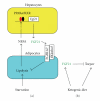FGF21 as an Endocrine Regulator in Lipid Metabolism: From Molecular Evolution to Physiology and Pathophysiology
- PMID: 21331285
- PMCID: PMC3038562
- DOI: 10.1155/2011/981315
FGF21 as an Endocrine Regulator in Lipid Metabolism: From Molecular Evolution to Physiology and Pathophysiology
Abstract
The FGF family comprises twenty-two structurally related proteins with functions in development and metabolism. The Fgf21 gene was generated early in vertebrate evolution. FGF21 acts as an endocrine regulator in lipid metabolism. Hepatic Fgf21 expression is markedly induced in mice by fasting or a ketogenic diet. Experiments with Fgf21 transgenic mice and cultured cells indicate that FGF21 exerts pharmacological effects on glucose and lipid metabolism in hepatocytes and adipocytes via cell surface FGF receptors. However, experiments with Fgf21 knockout mice indicate that FGF21 inhibits lipolysis in adipocytes during fasting and attenuates torpor induced by a ketogenic diet but maybe not a physiological regulator for these hepatic functions. These findings suggest the pharmacological effects to be distinct from the physiological roles. Serum FGF21 levels are increased in patients with metabolic diseases having insulin resistance, indicating that FGF21 is a metabolic regulator and a biomarker for these diseases.
Figures


Similar articles
-
FGF10 and FGF21 as regulators in adipocyte development and metabolism.Endocr Metab Immune Disord Drug Targets. 2011 Dec;11(4):302-9. doi: 10.2174/187153011797881166. Endocr Metab Immune Disord Drug Targets. 2011. PMID: 21696361 Review.
-
Fibroblast growth factor 21 regulates lipolysis in white adipose tissue but is not required for ketogenesis and triglyceride clearance in liver.Endocrinology. 2009 Oct;150(10):4625-33. doi: 10.1210/en.2009-0119. Epub 2009 Jul 9. Endocrinology. 2009. PMID: 19589869
-
FGF21 as a Hepatokine, Adipokine, and Myokine in Metabolism and Diseases.Front Endocrinol (Lausanne). 2014 Jul 7;5:107. doi: 10.3389/fendo.2014.00107. eCollection 2014. Front Endocrinol (Lausanne). 2014. PMID: 25071723 Free PMC article. Review.
-
Hepatic stearoyl CoA desaturase 1 deficiency increases glucose uptake in adipose tissue partially through the PGC-1α-FGF21 axis in mice.J Biol Chem. 2019 Dec 20;294(51):19475-19485. doi: 10.1074/jbc.RA119.009868. Epub 2019 Nov 5. J Biol Chem. 2019. PMID: 31690632 Free PMC article.
-
Thyroid hormone receptor regulates most genes independently of fibroblast growth factor 21 in liver.J Endocrinol. 2015 Mar;224(3):289-301. doi: 10.1530/JOE-14-0440. Epub 2014 Dec 11. J Endocrinol. 2015. PMID: 25501997
Cited by
-
Fgf21 impairs adipocyte insulin sensitivity in mice fed a low-carbohydrate, high-fat ketogenic diet.PLoS One. 2013 Jul 9;8(7):e69330. doi: 10.1371/journal.pone.0069330. Print 2013. PLoS One. 2013. PMID: 23874946 Free PMC article.
-
Cobalt chloride decreases fibroblast growth factor-21 expression dependent on oxidative stress but not hypoxia-inducible factor in Caco-2 cells.Toxicol Appl Pharmacol. 2012 Oct 15;264(2):212-21. doi: 10.1016/j.taap.2012.08.003. Epub 2012 Aug 10. Toxicol Appl Pharmacol. 2012. PMID: 22917661 Free PMC article.
-
FGF21 alleviates endothelial mitochondrial damage and prevents BBB from disruption after intracranial hemorrhage through a mechanism involving SIRT6.Mol Med. 2023 Dec 4;29(1):165. doi: 10.1186/s10020-023-00755-x. Mol Med. 2023. PMID: 38049769 Free PMC article.
-
Overfeeding Dairy Cattle During Late-Pregnancy Alters Hepatic PPARα-Regulated Pathways Including Hepatokines: Impact on Metabolism and Peripheral Insulin Sensitivity.Gene Regul Syst Bio. 2014 Apr 3;8:97-111. doi: 10.4137/GRSB.S14116. eCollection 2014. Gene Regul Syst Bio. 2014. PMID: 24737933 Free PMC article.
-
Growth hormone induces hepatic production of fibroblast growth factor 21 through a mechanism dependent on lipolysis in adipocytes.J Biol Chem. 2011 Oct 7;286(40):34559-66. doi: 10.1074/jbc.M111.285965. Epub 2011 Aug 17. J Biol Chem. 2011. PMID: 21849508 Free PMC article.
References
-
- Gospodarowicz D. Purification of a fibroblast growth factor from bovine pituitary. Journal of Biological Chemistry. 1975;250(7):2515–2520. - PubMed
-
- Gospodarowicz D, Bialecki H, Greenburg G. Purification of the fibroblast growth factor activity from bovine brain. Journal of Biological Chemistry. 1978;253(10):3736–3743. - PubMed
-
- Itoh N, Ornitz DM. Evolution of the Fgf and Fgfr gene families. Trends in Genetics. 2004;20(11):563–569. - PubMed
-
- Itoh N, Ornitz DM. Functional evolutionary history of the mouse Fgf gene family. Developmental Dynamics. 2008;237(1):18–27. - PubMed
-
- Itoh N. The Fgf families in humans, mice, and zebrafish: their evolutional processes and roles in development, metabolism, and disease. Biological and Pharmaceutical Bulletin. 2007;30(10):1819–1825. - PubMed
LinkOut - more resources
Full Text Sources
Other Literature Sources

